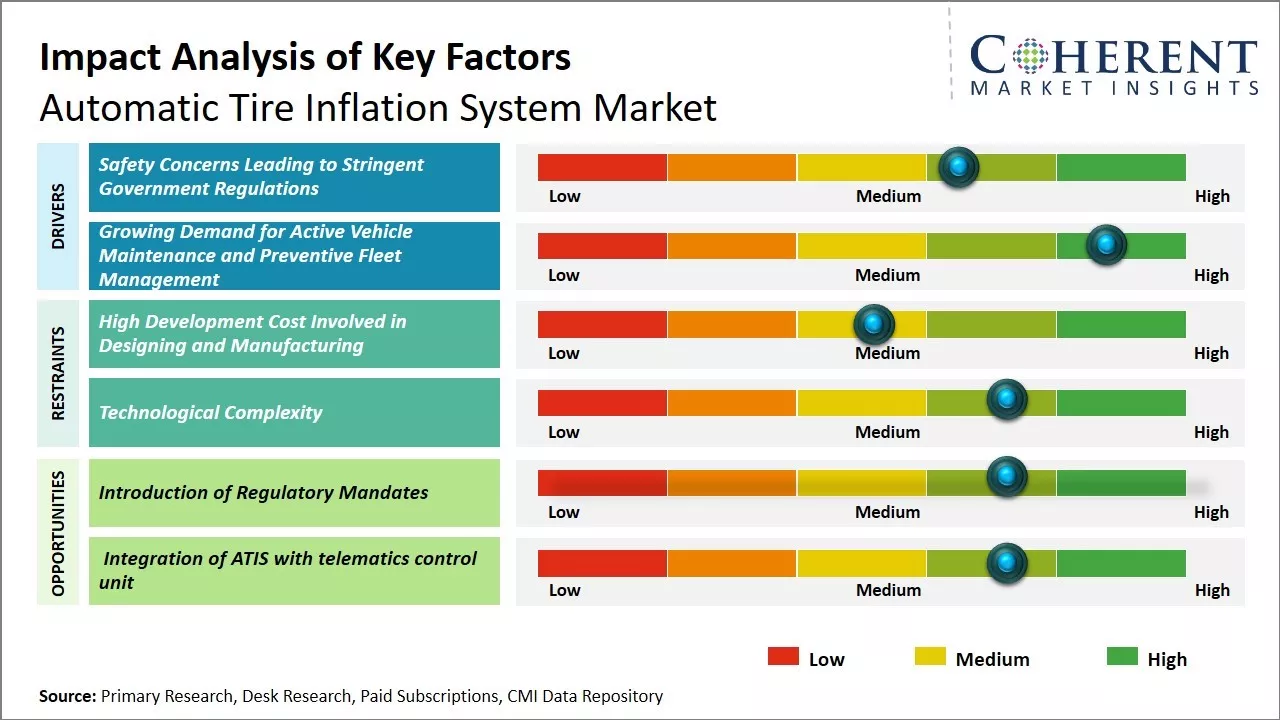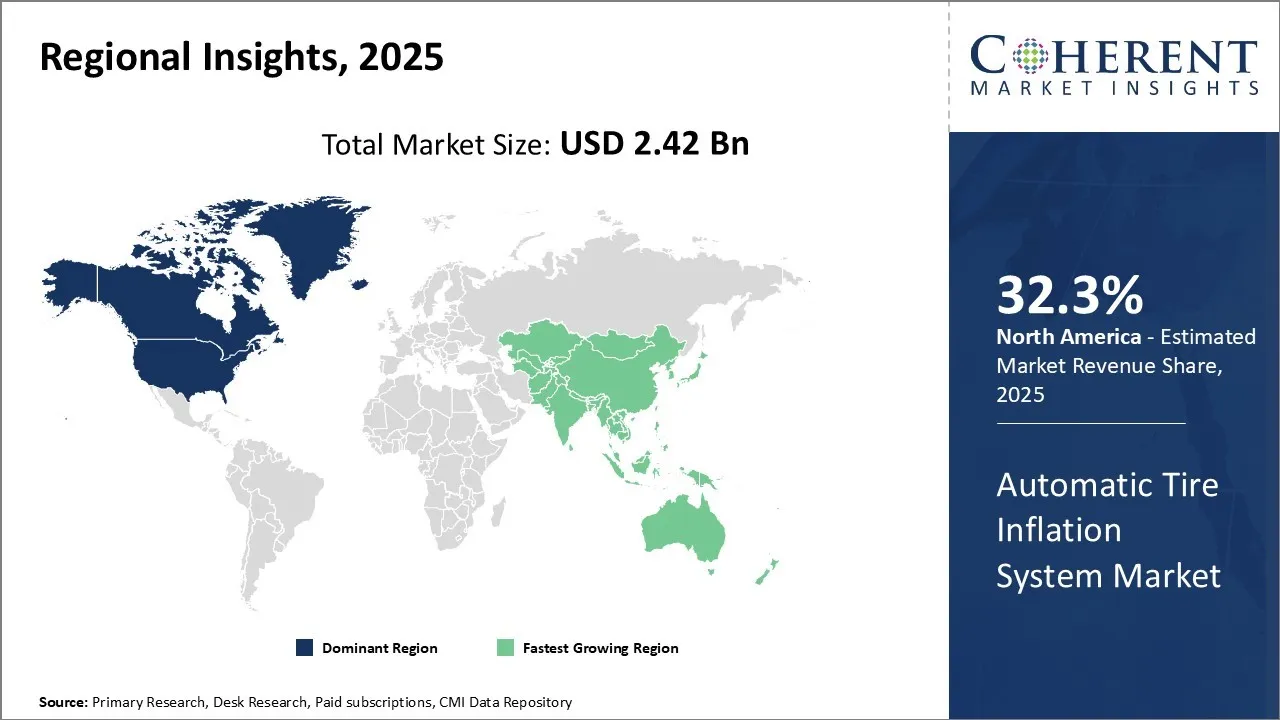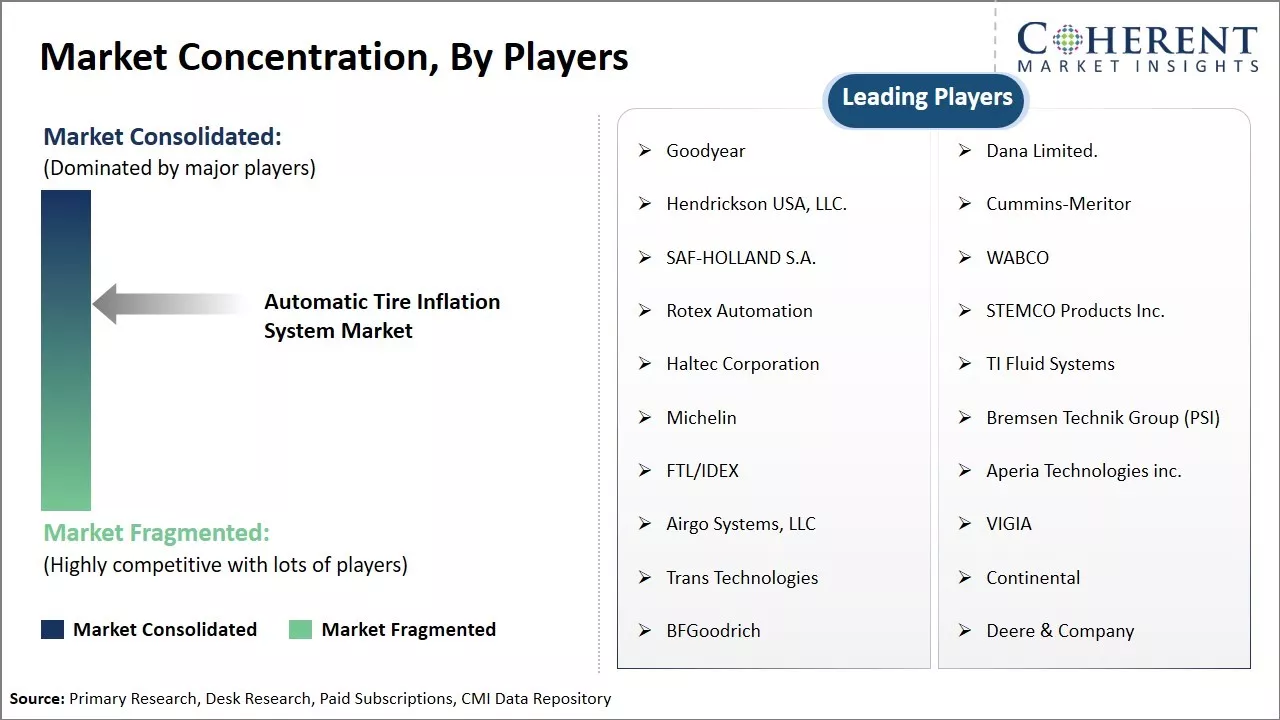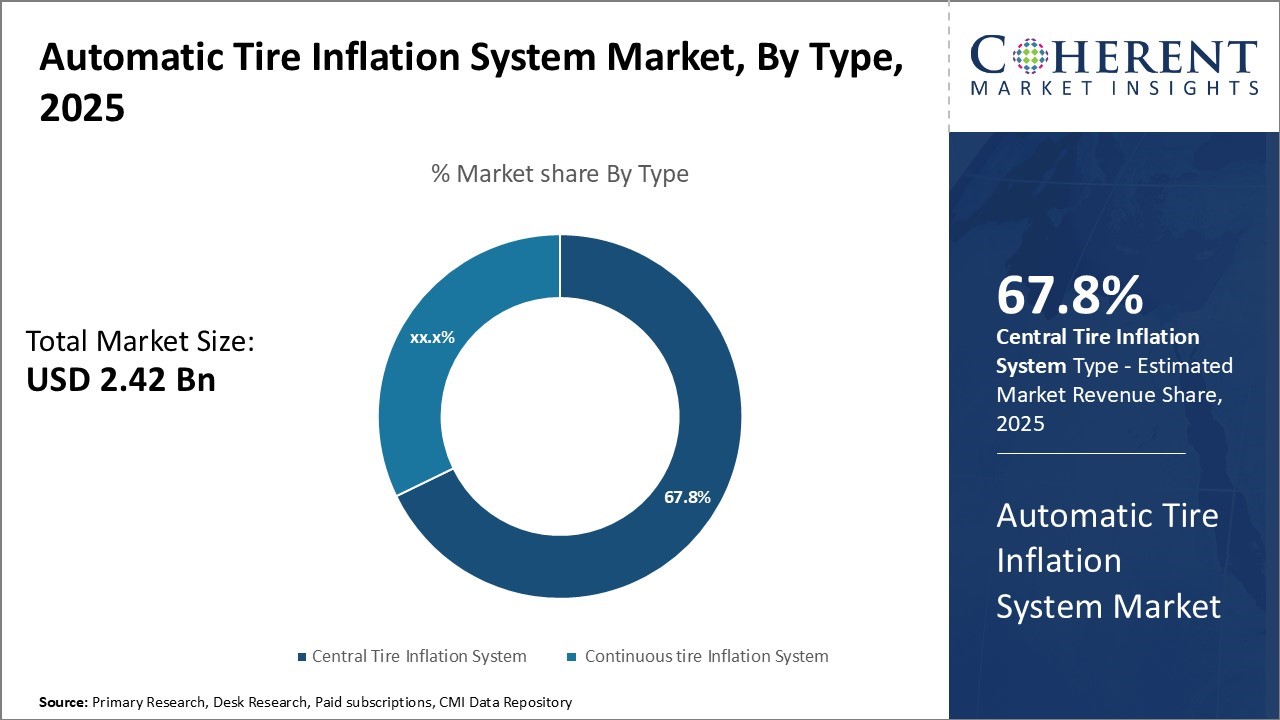Global Automatic Tire Inflation System Market Size and Share Analysis – 2025 to 2032
The automatic tire inflation system market is estimated to be valued at USD 2.42 Bn in 2025 and is expected to reach USD 4.32 Bn by 2032, growing at a compound annual growth rate (CAGR) of 8.6% from 2025 to 2032.

To learn more about this report, Download Free Sample
Key Takeaways
- Based on Type, Central Tire Inflation System Segment is estimated to contribute the highest share of 67.8% in 2025.
- In terms of Vehicle Type, The On-Highway Vehicles Segment is estimated to contribute the highest share of 64.9% in 2025 in the market.
- In terms of Sales Channel, The OEM Segment is estimated to contribute the highest share of 57.2% in 2025 in the market.
- North America has established itself as the dominant regional market for automatic tire inflation systems and is estimated to hold the market share of 32.3% in 2025.
Market Overview
The market is expected to witness significant growth during the forecast period. The growth of the market is attributed to growing concerns regarding vehicle safety and efficiency. Major automakers are focusing on incorporating automatic tire inflation systems to offer enhanced safety, comfort, and fuel efficiency. Additionally, the adoption of advanced tire pressure monitoring systems (TPMS) in commercial vehicles will further boost the demand for automatic tire inflation systems. Reducing maintenance cost is also encouraging large fleet operators to equip their vehicles with ATIS. Stringent regulations regarding vehicle safety and fuel economy are further expected to promote the adoption of automatic tire inflation systems.
Current Events and Its Impacts
|
Current Events |
Description and its impact |
|
Aperia launches Halo Connect i3 for Total-Vehicle Tire Automation |
|
|
Michelin and Valeo Collaborate to Create Smart Tire Inflation Systems |
|
Uncover macros and micros vetted on 75+ parameters: Get instant access to report
Emergence of New Technologies
The Automatic Tire Inflation System (ATIS) market is highly dynamic with new technologies focusing on enhancing safety, efficiency, and real-time monitoring for commercial, agricultural, and military fleets. The most striking innovation is probably the integration of smart ATIS with IoT-based telematics platforms, making it possible to transmit tire pressure data in real time to fleet managers. It boosts predictive maintenance and reduces downtime by making it possible to detect underinflated or leaky tires early.
One of the most important developments is the application of adaptive inflation systems, where tire pressure is automatically adjusted relative to terrain, load, and driving conditions. These find a particularly critical use in off-road trucks and military trucks, where ground conditions can significantly impact tire performance and vehicle stability. Dual-mode inflation/deflation technology is also gaining traction, allowing dynamic pressure adjustment while driving, enhancing traction and reducing wear.
Additionally, manufacturers are also adding energy-efficient compressors, compact control modules, and self-powered sensor systems, hence making ATIS a better fit for retrofitting existing fleets. The industry is also experiencing advancements in sealed rotary unions and fail-safe pressure regulators, which strengthen system longevity in extreme environments.
Market Driver
- Safety Concerns Leading to Stringent Government Regulations
As automotive safety continues to be a major priority for both consumers and governments across the world, tire safety in particular has come under increased scrutiny in recent years. For instance, the California Air Resources Board (ARB) enforces regulations to reduce greenhouse gas emissions from vehicles operating inefficiently with under inflated tires. These regulations apply to vehicles with a gross vehicle weight rating of 10,000 pounds (lbs.) or less. Tire failures and under inflation have been identified as significant contributors in road accidents.
In response, regulatory agencies are introducing newer safety standards mandating technologies that can automatically monitor and maintain optimal tire pressure levels. For commercial fleets that carry passengers or goods, penalties for non-compliance with tire safety norms have also been made more stringent. This is prompting large fleet operators to adopt automatic tire inflation systems especially integrated with remote fleet monitoring systems.
Such systems not only ensure compliance but also deliver efficiency gains through reduced fuel consumption and lower maintenance costs associated with improperly inflated tires over long distances and varying outdoor conditions. Significant research is also ongoing to apply similar tire pressure monitoring on passenger vehicles through either retrofits or direct OEM integration. If regulatory support increases for passenger vehicles as well, it could lead to a massive uptick in aftermarket installations and factory fits of automatic tire inflation technology across multiple vehicle categories.
- Growing Demand for Active Vehicle Maintenance and Preventive Fleet Management
With the rapid growth of connected vehicles and integrated vehicle health management systems, there is a discernible shift in preferences towards active and predictive vehicle maintenance over traditional time- or mileage-based servicing. Telematics allow real-time tracking of various vehicle parameters and remote diagnosis of anomalies. This has created the demand for automotive solutions that can autonomously detect and address minor issues before they escalate into expensive repairs or downtime. Keeping tires at their optimal pressure falls right within this paradigm of proactive upkeep of commercial vehicles.
Market Opportunities: Introduction of Regulatory Mandates
However, the market sees significant growth opportunities with the introduction of regulatory mandates. Adoption is expected to increase with stricter fuel economy and vehicle safety norms. Moreover, increasing focus on predictive vehicle maintenance and preventive tire care offers opportunities for aftermarket system sales and installations. With rising vehicle usage and road travel, demand for convenience and tire monitoring is growing, presenting an avenue for innovators to enhance features and value proposition.
Automatic Tire Inflation System Market Insights, By Type
The central tire inflation system segment is estimated to contribute the highest share of 67.8% in 2024 in the global automatic tire inflation system market owing to its proven durability even under heavy usage. As central tire inflation systems are directly connected to the vehicle's compressed air source, they ensure tires maintain optimal pressure continuously without any external intervention.
This independence from manual monitoring and refills makes central tire inflation systems highly attractive for commercial fleets operating long-haul trucks and buses that log high annual mileages. Their automatic operation removes human error which can cause accidents from under-inflated tires. The set-and-forget functionality of central tire inflation systems saves fleet operators from frequent downtimes for tire maintenance and repairs. This enhances vehicle uptime and productivity over time.
Central tire inflation systems also improve overall tire life significantly by preventing premature wear form irregular pressure levels. Commercial vehicles rely on maximizing mileage from each set of expensive tires to reduce operational costs. Central tire inflation systems help meet this objective through their round-the-clock pressure maintenance capability.
For applications involving off-road or adverse conditions like military vehicles, agriculture equipment, central tire inflation systems offer unmatched reliability compared to manual inflation methods prone to failures. Their tough automotive-grade components withstand extreme vibration and weather extremes with minimal maintenance needs. This ruggedness and "fit and forget" quality attract demand from businesses investing in assets with long lifecycles like construction machinery.
For instance, IDEX Sealing Solutions, offers Central Tire Inflation Systems (CTIS), which maximize vehicle mobility and performance in demanding terrain and conditions, by adjusting the tire pressure to improve traction, eliminate tire leak and reduce soil compaction. This gives the driver complete control over a vehicle.
Automatic Tire Inflation System Market Insights, By Vehicle Type
The on-highway vehicles segment is estimated to contribute the highest share of 64.9% in 2025 in the market owing to rising transportation activities globally. Rapid growth of e-commerce and just-in-time inventory models has increased the demand for commercial trucks and trailers to timely deliver goods over long distances. Rising incomes and urbanization also drive personal transportation, boosting passenger vehicle production annually.
Both trends necessitate maintaining large commercial and private vehicle fleets in good working condition over many years as replacements are costly. On-highway vehicles like trucks and buses traverse varied terrains and weather, placing tire integrity under consistent stress. Proper tire inflation plays a vital role in avoiding accidents and maintaining uptime of transportation assets. Automatic Tire Inflation Systems help fleet managers economically achieve these goals through their set-and-forget convenience and ability to minimize tire-linked vehicle downtime.
For instance, Cummins Inc., American multinational corporation, has equipped Meritor Tire Inflation System (MTIS) on more than 1 million on-highway vehicles such as trailers till now, which helps keep tires properly inflated to reduce wear and increase fuel economy.
Automatic Tire Inflation System Market Insights, By Sales Channel
The OEM segment is estimated to contribute the highest share of 57.2% in 2025 in the market due to stricter emission regulations being enforced globally. Growing environmental concerns mandate minimizing commercial vehicle downtime and improving fuel-efficiency. Automatic tire inflation systems address these imperatives when factory-fitted by OEMs.
Their round-the-clock pressure optimization enhances aerodynamics to boost miles-per-gallon, helping fleet owners comply with emission norms. Pre-installed OEM systems also simplify maintenance workflows against manual refilling equipment which needs periodic replacement. This bodes well for resale values of equipped vehicles.
Rising road accident penalties make safety compliance a top priority for commercial fleet owners and transport Ministers. Automatic Tire Inflation Systems pre-empt tire pressure related accidents by maintaining optimal levels automatically without human errors of omission. This mitigates legal liabilities and insurance costs in the long-run when fitted by OEMs during production.
Regional Insights

To learn more about this report, Download Free Sample
North America Automatic Tire Inflation System Market Analysis and Trends
North America has established itself as the dominant regional market for automatic tire inflation systems and is estimated to hold the market share of 32.3% in 2025. This can be attributed to a well-established automotive industry in countries like the U.S. and Canada. Commercial vehicle manufacturers in North America are actively adopting advanced tire technologies to improve fuel efficiency as well as vehicle and driver safety. Many fleets and logistics companies are investing in ATIS to reduce maintenance costs associated with tire checks and repairs. The demand is further strengthened by regional presence of leading ATIS providers who can work closely with fleet managers for installation and service
Asia Pacific Automatic Tire Inflation System Market Analysis and Trends
Asia Pacific is poised to be the fastest growing regional market in the coming years. Economic development across countries like China and India have led to rapid growth of commercial vehicle fleet. Apart from domestic demand, Asia Pacific is also emerging as an export hub for automotive and logistics industries. This has increased vehicle miles travelled and emphasis on reducing operating expenses.
ATIS offers an effective solution to manage tire pressure across long-haul trucks and cargo vehicles. Additionally, countries in Southeast Asia such as Indonesia, Malaysia, and Thailand are witnessing expansion of mining and construction sector which heavily relies on commercial vehicles. Original equipment manufacturers based in Asia are also steadily enhancing driver assist technologies. This is raising adoption of ATIS as an integrated solution.
Automatic Tire Inflation System Market – Dominating Countries
China Automatic Tire Inflation System Market Analysis and Trend
China is a fast-growing market for automatic tire inflation system, fueled by expanding freight transportation, building, and agricultural sectors. As the government is encouraging modernized transportation and logistics, ATIS is being integrated into new fleets of heavy-duty vehicles, especially for long-haul and mining applications.
United States Automatic Tire Inflation System Market Analysis and Trend
The United States leads the global automatic tire inflation system market, driven by tough Department of Transportation (DOT) regulations, established trucking infrastructure, and high utilization of commercial trailers and heavy-duty trucks. Safety, tire longevity, and fuel efficiency are top priorities to fleet owners, making ATIS a best investment among logistics companies.
Germany Automatic Tire Inflation System Market Analysis and Trend
Germany is at the forefront of the European market boom due to its solid foundation of automobile production and stringent automobile safety and efficiency requirements. Commercial transport as well as off-road applications are experiencing greater uptake of automatic tire inflation system supported by innovation from leading OEMs and Tier 1 providers.
Market Report Scope
Automatic Tire Inflation System Market Report Coverage
| Report Coverage | Details | ||
|---|---|---|---|
| Base Year: | 2024 | Market Size in 2025: | USD 2.42 Bn |
| Historical Data for: | 2020 To 2024 | Forecast Period: | 2025 To 2032 |
| Forecast Period 2025 to 2032 CAGR: | 8.6% | 2032 Value Projection: | USD 4.32 Bn |
| Geographies covered: |
|
||
| Segments covered: |
|
||
| Companies covered: |
Goodyear, Dana Limited., Hendrickson USA, LLC., Cummins-Meritor, SAF-HOLLAND S.A., WABCO, Rotex Automation, STEMCO Products Inc., Haltec Corporation, TI Fluid Systems, Michelin, Bremsen Technik Group (PSI), FTL/IDEX, Aperia Technologies inc., Airgo Systems, LLC, VIGIA, Trans Technologies, Continental, BFGoodrich, Deere & Company |
||
| Growth Drivers: |
|
||
| Restraints & Challenges: |
|
||
Uncover macros and micros vetted on 75+ parameters: Get instant access to report
Automatic Tire Inflation System Industry News
- In January 2024, Michelin and Valeo partnered to combine real-time tire monitoring data with ATIS on passenger and light commercial vehicles. This partnership improved fuel efficiency, safety, and maintenance cost savings by ensuring maximum tire pressure at all times.
- In April 2024, Aperia Technologies released the Halo Connect i3, a next-generation ATIS with full-vehicle monitoring and automatic inflation capacity. The system includes real-time tire pressure monitoring and automatic adjustment, greatly cutting downtime and maintenance expenses.
Analyst View
- Automatic tire inflation systems (ATIS) are gaining widespread use motivated by intense consumer concern for road safety, improved vehicle performance, and fuel efficiency. Increasing awareness regarding the negative effect of varying tire inflation on fuel consumption and tire life forms the key driver. Moreover, strict government regulations aimed at minimizing vehicle emissions and promoting road safety offer significant support to ATIS uptake.
- Yet, the high initial investment that comes with installation and integration of ATIS in cars continues to be a major deterrent for market growth. End-users, particularly in price-conscious markets, will see the device as an extra or prestige item and not as a necessary component, hence its low penetration. Further, the issues regarding retrofitting the systems into older models further deter cost-conscious end-users from massive uptake of the technology.
- However, there are a great many growth prospects in commercial vehicles, particularly heavy-duty trucks, buses, and trailers, where fleet owners persistently look for ways to cut operational expenses. Joint efforts from ATIS manufacturers and automobile OEMs to make these systems an integral standard feature in vehicles could significantly increase demand in the short term.
- Geographically, North America is dominating adoption right now based on a well-established automobile industry and strong presence of top manufacturers of promoting advanced safety technologies. Yet, the Asia-Pacific region is poised to become the growth leader in future years due to fast-developing automobile infrastructure, enhanced regulatory environments, and growing fleet operations across economies of China and India.
Market Segmentation
- By Type
- Central Tire Inflation System
- Continuous tire Inflation System
- By Vehicle Type
- On-Highway Vehicle
- Light Duty Vehicle
- Heavy Duty Vehicle
- Off-Highway Vehicle
- Agriculture Tractors
- Construction Equipment
- By Sales Channel
- OEM
- Aftermarket
- By Region
- North America
- U.S.
- Canada
- Latin America
- Brazil
- Argentina
- Mexico
- Rest of Latin America
- Europe
- Germany
- U.K.
- Spain
- France
- Italy
- Russia
- Rest of Europe
- Asia Pacific
- China
- India
- Japan
- Australia
- South Korea
- ASEAN
- Rest of Asia Pacific
- Middle East
- GCC Countries
- Israel
- Rest of Middle East
- Africa
- South Africa
- North Africa
- Central Africa
- Key Players
- Goodyear
- Dana Limited.
- Hendrickson USA, LLC.
- Cummins-Meritor
- SAF-HOLLAND S.A.
- WABCO
- Rotex Automation
- STEMCO Products Inc.
- Haltec Corporation
- TI Fluid Systems
- Michelin
- Bremsen Technik Group (PSI)
- FTL/IDEX
- Aperia Technologies inc.
- Airgo Systems, LLC
- VIGIA
- Trans Technologies
- Continental
- BFGoodrich
- Deere & Company
Sources
Primary Research Interviews
- Executives from leading ATIS manufacturers (e.g., Dana Incorporated, Meritor, Inc.)
- Fleet managers from major logistics companies
- Regulatory compliance specialists from transportation agencies
- Distributors and aftermarket service providers
- Others
Databases
- Bloomberg Terminal (financial and market data)
- S&P Global Market Intelligence (competitive and technical analysis)
- Others
Magazines
- Tire Business (tire technology and aftermarket trends)
- Automotive News (OEM and supplier innovations)
- Fleet Owner (commercial vehicle operations)
- Modern Tire Dealer (retail and service insights)
- Others
Journals
- SAE International Journal of Commercial Vehicles (technical research)
- Journal of Automobile Engineering (vehicle systems)
- International Journal of Automotive Technology (industry applications)
- Others
Newspapers
- The Wall Street Journal (automotive sector developments)
- Financial Times (global market trends)
- Bloomberg (regulatory and economic impacts)
- Others
Associations
- Rubber Manufacturers Association (RMA) (tire standards)
- American Automotive Association (AAA) (safety guidelines)
- International Tire & Rubber Association (ITRA) (industry best practices)
- Others
Public Domain Sources
- National Highway Traffic Safety Administration (NHTSA) (safety data)
- U.S. Department of Transportation (DOT) (regulatory filings)
- European Commission Mobility & Transport Reports (EU standards)
- Others
Proprietary Elements
- CMI Data Analytics Tool
- Proprietary CMI Existing Repository of information for last 8 years
Share
Share
About Author
Gautam Mahajan is a Research Consultant with 5+ years of experience in market research and consulting. He excels in analyzing market engineering, market trends, competitive landscapes, and technological developments. He specializes in both primary and secondary research, as well as strategic consulting across diverse sectors.
Missing comfort of reading report in your local language? Find your preferred language :
Transform your Strategy with Exclusive Trending Reports :
Frequently Asked Questions
EXISTING CLIENTELE
Joining thousands of companies around the world committed to making the Excellent Business Solutions.
View All Our Clients


